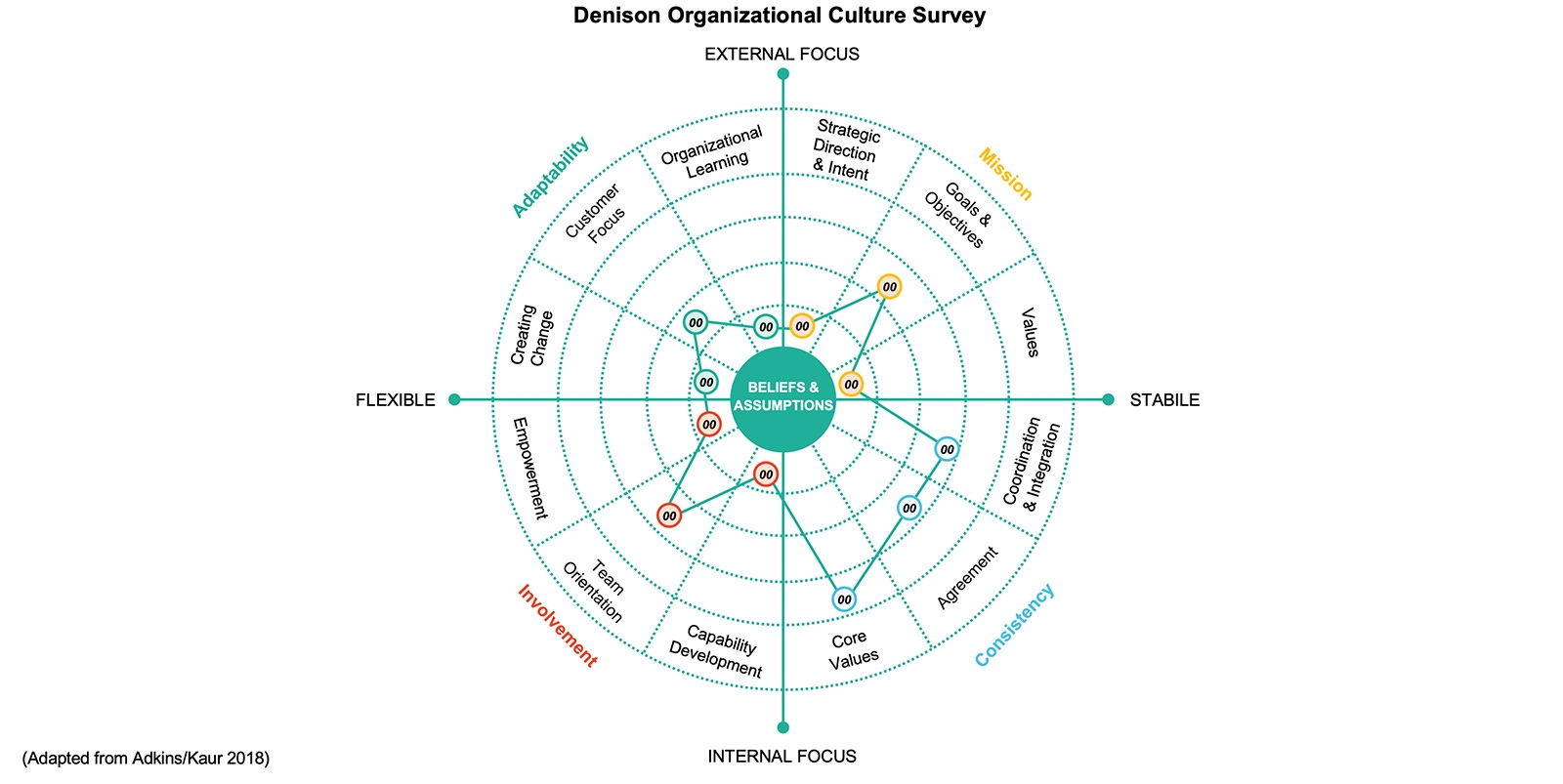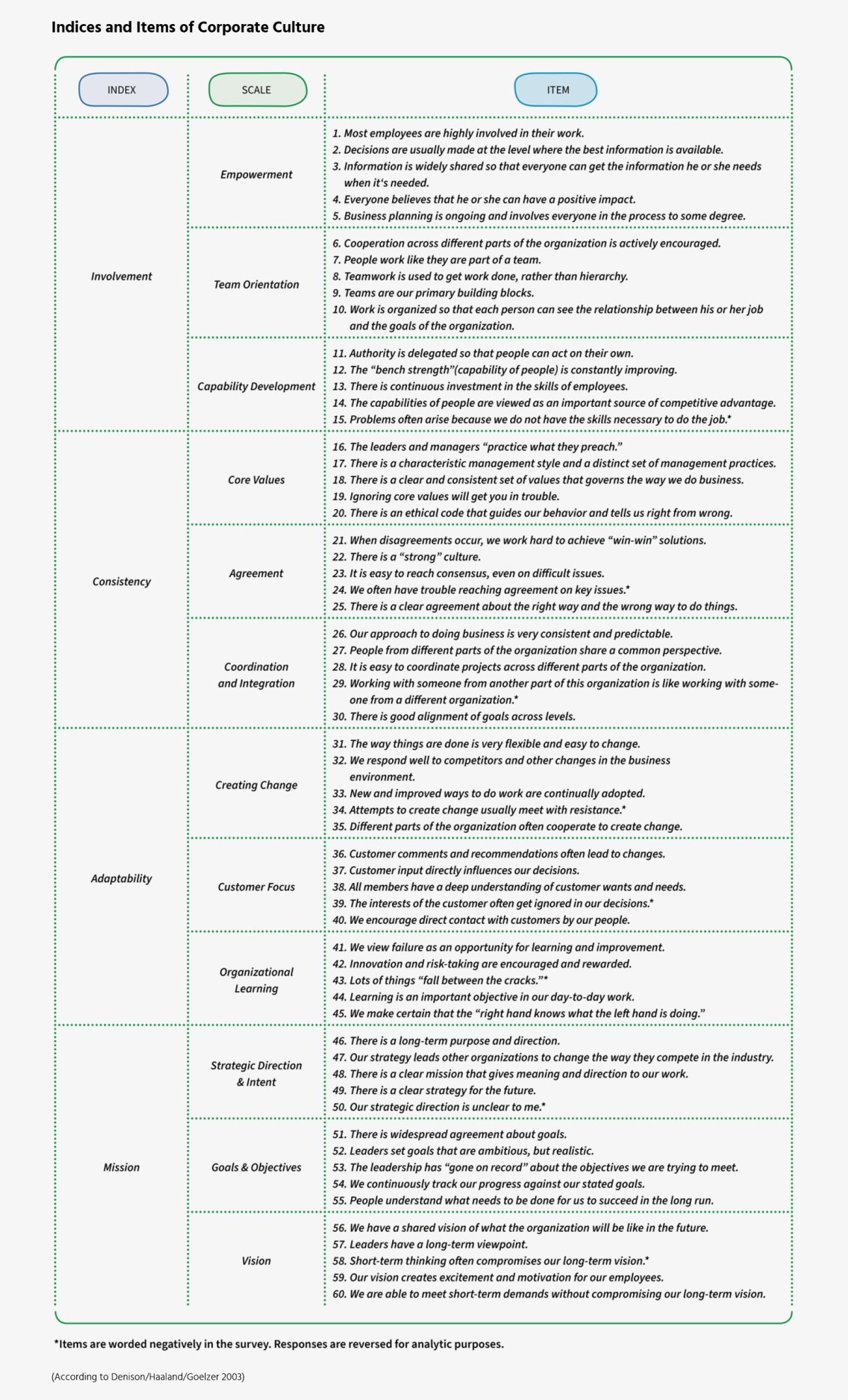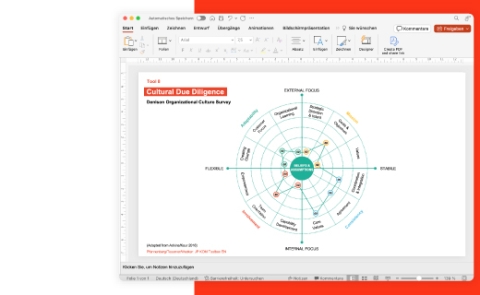Cultural Due Dilligence

Guiding question
Which norms and values influence the behavior of employees and the rules for dealing with each other?
Objectives
- Uncover the norms and values underlying the behavior of managers and employees
- Identify similarities and differences in the corporate cultures of companies in the context of mergers & acquisitions
- Recognize risks and contradictions in the organizational culture, e.g., in case of tension between internal and external requirements
- Develop action-oriented approaches for aligning employees with corporate goals, e.g., in change processes
Implementation
In mergers & acquisitions, but also in change processes, corporate culture – the system of norms and values in the organization that underlies behavior – plays a key role in the success of the project: The norms and values of managers and employees are constitutive for their commitment to change projects. Prior to the development of organizational and communicative measures, the examination of the corporate culture provides important information on the feasibility of the change objectives.
When two companies or divisions are to be merged, different behavioral patterns and expectations can form a major obstacle to a jointly oriented approach and merging; a cultural due diligence examines the cultural opportunities and risks at the acquisition object (target) as part of the due diligence process. A comparative study reveals the compatibility – the similarities and differences – in the corporate cultures of the acquiring and acquired company.
Combined content analysis and survey methods are often chosen to capture the corporate culture and complex behavioral patterns of employees. Typical subjects of investigation are leadership, work and communication styles, routines, clothing, status symbols, and employees' willingness to collaborate and change (cf. Fuhlrott/Durst 2010, p. 177). The following methods are used – often in combination (cf. ibid.):
- Standardized surveys enable a high degree of representativeness and often – via the commissioned institute – benchmarking with companies in the same industry or the same region. The most internationally known tool of this kind is the Denison Organizational Survey. It can be used to ascertain whether and to what extent employees are aligned with the company's goals in their daily work. For this purpose, the corporate culture is recorded with three sub-characteristics each in four culture characteristics: Mission, Adaptability, Commitment, and Consistency (cf. Denison/Haaland/Goelzer 2003, 208). The results of the survey are presented in a spider diagram (Denison Culture Model) with five-point scaling. About the effective axes Internal vs. external focus and Flexible vs. Stable a rough typification of the corporate cultures is made (see Fig. Tool).
- Guided interviews with managers of the own company, which partly replace direct observation of behavior, e.g., in the company to be acquired, where this is prohibited for antitrust reasons until the merger (see Tool 9: Communications Audit)
- Analysis and comparison of published statements on the mission statement and other values, vision, mission as well as (leadership) principles recorded in media
- Content analysis and analysis of the communication style in corporate media and other artifacts such as letters, mails, notices, etc. The significance of issues and of explicitly expressed norms and values in the content analysis is evaluated by scoring on a scale of 1 to 5. Language analysis according to Schulz von Thun (cf. Tool 36) can also be used to draw conclusions about the norms and values in relationship and expectation management, among other things.
Such is the typical approach to cultural due diligence:
- Pre-survey, e.g., in focus groups or in a survey of managers
- Design of the questionnaire and the survey
- Analysis of survey results:
- Differences between companies/areas/regions and opportunities/risks
- Initiation of organizational and communicative improvement measures, e.g., mission statement project
Theory: Organizational culture
Through their studies of Japanese management culture as a success factor, Peters/Waterman (1982) discovered corporate culture as a key to corporate success. They argue that corporate culture can be managed to support corporate strategy. Since then, corporate culture has been regarded as a problem-solving program of companies/organizations.
The concept of organizational or corporate culture transfers the concept of culture from cultural anthropology, which studies people in their relationship to their culture, to organizations. According to this, culture – the system of shared norms and values, attitudes and paradigms in a community/society – determines the behavior of people in the organization and the way they present themselves to the outside world. According to Schein, corporate culture manifests itself on three levels (1984):
Visible artifacts. Visible structures and processes in the company, such as “architecture, technology, office layout, manner of dress, visible or audible behavior pattern, and public documents such as charters, employee orientation materials, stories.” The artifacts can be seen by everyone but often they are “not decipherable” – they are strongly subject to interpretation.
Professed values. The norms and standards of the company as laid down in strategies, objectives, but also in guiding principles. However, some maxims and prohibitions are not visible to everyone and yet are relevant.
Basic assumptions. Unconscious views, perceptions, thoughts and feelings as the basis for values and actions, e.g., about the environment, truth, time, people and human actions, social relations.

